In my home, we have always cooked rice in an open pot of boiling water and drained the excess water off once the rice is cooked. This helps in removing the excess starch in rice (the resulting kanji vellam is used to starch clothes) and the grains remain separate, the way we like it.
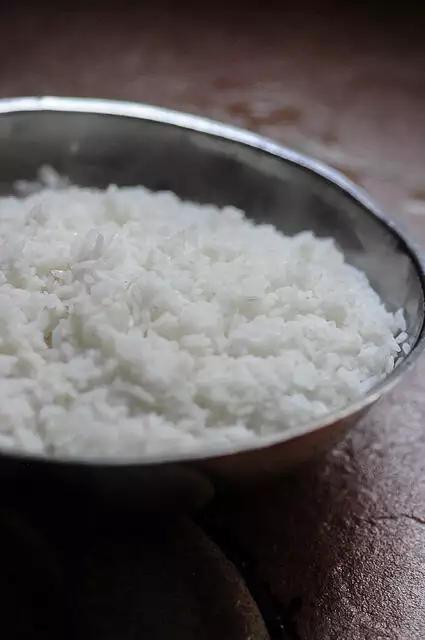
My in-laws consume raw rice which is cooked in a pressure cooker or rice cooker, always. The consistency is more sticky and this works well for the kind of rasam and kuzhambu the rice is served with, not to mention pongal and other dishes made with this rice.
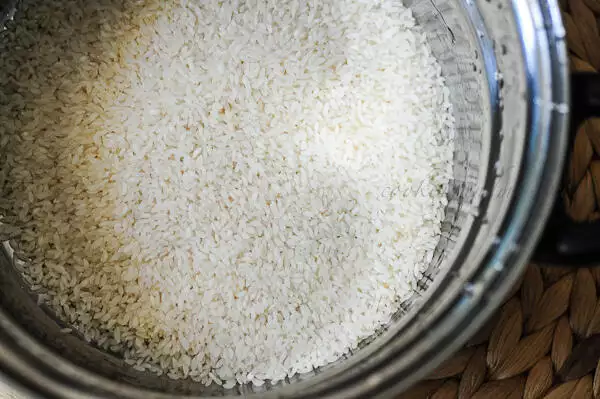 |
| Seeraga Samba Rice |
I use ponni par-boiled rice on a daily basis in Singapore (available in Fairprice in 5kg bags and all stores in Little India) and Basmati or Seeraga Samba rice for Biryani, Pulao, and other one-pot mixed rices.
While I use my rice cooker for the every day rice, I cook rice for biryani, pulao, differently and wanted to share the method with you. I get a lot of comments on my pulao posts asking how the rice grains remain separate after making the dish and the answer is – being able to control how much your rice gets cooked helps you get that consistency in biryani and pulao.
How to Cook Rice for Biryani, Fried Rice, Pulao
Preparation time: 30 minutes
Cooking time: 10 minutes
Makes 2.5 cups cooked rice
Ingredients:
1 cup of basmati rice or seeraga samba rice
3 cups of water
1 tsp of salt
How to Cook the Rice:
1. Wash and soak the rice in enough water to cover it for 30 mins.
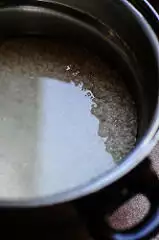
2. After 30 mins, drain the water completely, add 3 cups of fresh water (or enough to cover the rice by 2-3 inches) and place on the stove on medium flame.
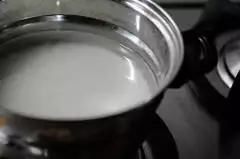
3. Add salt and bring to boil.
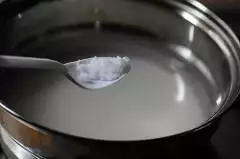
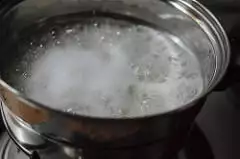
4. Once the water is boiling, lower flame and let the rice cook in the open pot for 10-12 mins. You will see the rice getting enlarged and the water level going down.
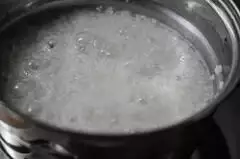
5. After 10 mins, check the grains to see if it’s cooked. Generally I pinch a grain or rice between my thumb and forefinger and see if it smushes smoothly. Or, just put some grains of rice in your mouth and bite into them to see if they are hard inside. It’s done when the rice is soft yet not mushy. It’s better to leave it a bit underdone than overdone if you are in doubt.
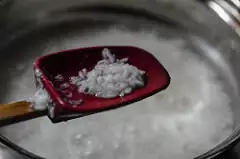
6. Switch off flame and immediately drain the rice in a colander. Let it sit on an uneven platform for 30 mins or so. You can fluff it with a fork midway so that the water drains out completely.

That’s it! You can use this rice for making biryani, pualo, fried rice, or any mixed rice variety. The grains will remain separate and the flavours will be nicely incorporated once you are done.
Tip: You can add a few drops of oil to the boiling water if you want. I sometimes do this but it’s not really super necessary.
Tip from a reader, Lakshmi: Add a few drops of lemon juice to the cooked rice when it’s hot and mix well. The colour of the rice will be super white.

My question is that I use the forefinger method to determine how.much water to add to.the rice. But when I cook rice, as the water boils, the rice appears not to be tender thus needing.more water. How can you tell just by looking at the rice if it is .being cooked or not.being cooked (needing abit more water)? Once the water boils and evaporates, is it at that very moment when.you feel a grain of rice if it is being cooked with the right amount of water? Can you post pictures of rice that was being cooked but needed xamore water vs rice that is well cooked once the water evaporates?
i’ll try to post those pictures but basically, add more water in the beginning than you think you need. every type of rice is different and needs various levels of water and cooking time, not to mention the heat you apply affect this largely too. it’s hard to put every scenario in here in the form of pictures. For the cook and drain method, check a grain of rice between fingers or by biting into one. If it is soft, then you’re done. If it has a harder centre, give it a few more mins. Needs some trial and error due to the variables, I’m afraid
Can you explain how to cook the jeeraga samba rice and is it same as jeeraga sala rice?
Other than biriyani what else we can use jeeraga samba rice for like pongal, curd rice?
What about tamarind rice, lemon rice, mango rice? Maybe no to this because it is sticky?
hi, i am not familiar with jeeraga sala rice but yes jeeraga samba can be cooked in the same way
I do it both ways (draining or not draining method), however for biryani rice, apart from salt, I always add whole spices while boiling the rice.. That way the rice gets wonderful garam masala aroma mixed with basmati fragrance. If I drain the rice, I add few tsp of ghee so the grain does not stick, and if not draining then I lightly dry roast the soaked rice in ghee before adding water.
cheers~